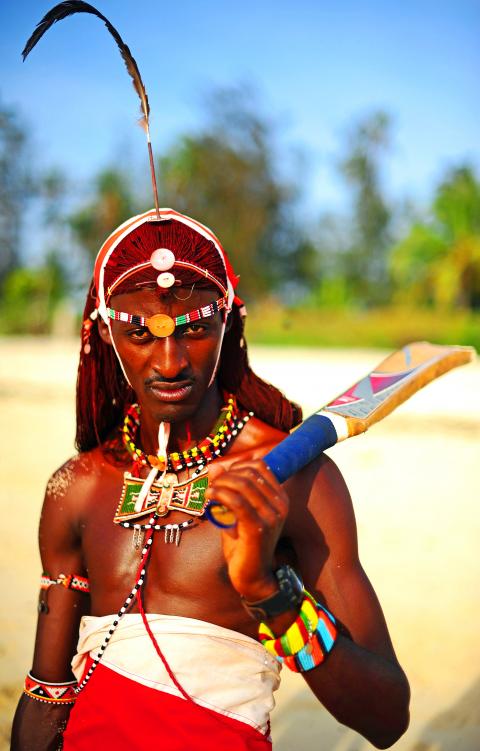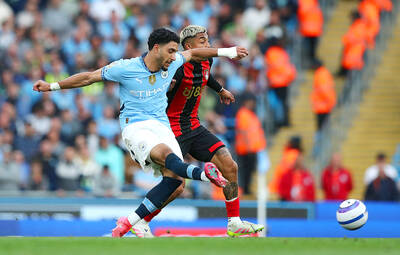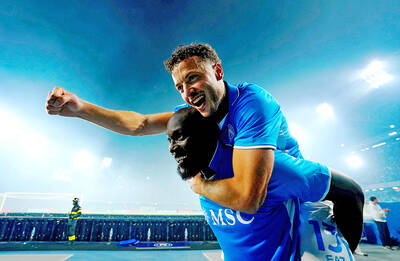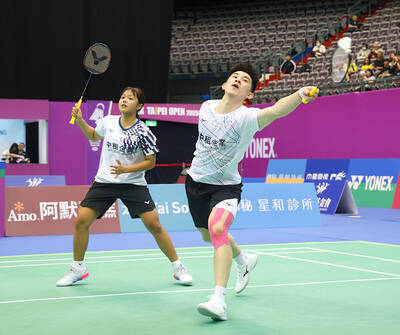Standing in front of the wicket, Kenyan cricketer and Masai warrior Francis Meshame sports his traditional headdress and red robes, but has swapped his shield and spear for protective pads and a cricket bat.
“It is an easy game because when you bowl, it is just like throwing the spear,” said Meshame, part of a team of cricketers from Kenya’s famous Masai tribe who have embraced the game, but not the sport’s traditional whites.
“The pads we use are just like the shields we use when we are fighting, and the bat itself is just like the rungu, the clubs that we use,” the 29-year-old batsman said.

Photo: AFP
Cricket, imported into Kenya during British colonial rule, is played only in the east African country’s largest cities.
None of the Masai on this team had even heard of the sport until five years ago when Aliya Bauer, a South African cricket fan, began introducing local schoolchildren in the village of Il Polei to the game.
Based in Kenya’s remote central highlands of Laikipia, they have traveled to the Indian Ocean port of Mombasa for this match.
Bauer, now 34, has spent more than seven years in Kenya. Before starting work on a project studying primates in Laikipia, she was an international cricket scorer in her native South Africa.
Watching the schoolchildren play in Il Polei, “the older boys who were passing by began to get interested,” she said.
One of the team’s 20 players, Ole Sonyanga Weblen Ngais, 23, recalls being intrigued by this “very strange game.”
“Teaching people a new sport they have never seen is quite challenging,” Bauer said, adding that progress was also hampered by a lack of facilities and equipment.
Thanks to donations, the team, dubbed the Masai Cricket Warriors, is now equipped with bats, balls, gloves and pads.
The Masai took to the game like ducks to water.
The “moranes [young Masai warriors] learned to throw the spear when they were very young. It makes them very good bowlers,” Bauer said.
The enthusiasm is real. One player does not hesitate to walk 16km to the practice field and home again.
Despite limited resources, the team has come a long way since they first put bat to ball. The Masai Cricket Warriors have staged exhibition matches at the Laikipia Highlands Games, where the tribes of the region engage in athletics, soccer and other events, for the past two years running.
Last year, trainers from Cricket Without Borders came to Laikipia and awarded several of the team’s players their official -coaching diploma.
Twelve of the players have been in Mombasa since late January on a two-month training course at the Nursery of Cricket Legends, an academy opened by former national team players. They recently demonstrated their cricket skills on the sidelines of a Kenya-Ireland match.
The team also uses cricket metaphors to deliver messages within the highly traditional and patriarchal Masai community, in which early marriage and female genital mutilation are firmly rooted customs.
They visit schools to talk about AIDS prevention, the fight against female genital mutilation, polygamy and early marriage, gender equality, environmental protection and battling alcoholism and drug addiction.
Today, 20 schools in Laikipia offer introductory cricket, Bauer said proudly.
By contrast, in the rest of the country, cricket is far less popular than athletics, soccer or seven-a-side rugby, and it continues to weaken even though the national team reached the semi-finals of the 2003 World Cup.
And Bauer’s Masai Cricket Warriors, living in relative isolation, still lack the opponents — and the money — they need to progress.
The team receives no financial assistance from the national cricket body, Cricket Kenya, and all its members are volunteers, including Bauer, who now works full-time as coach.
The team is currently working with organizations and sponsors to raise funds to enable them to take part in a major amateur tournament in Cape Town, South Africa, later this year.
Even if they lack the means, the Masai Cricket Warriors have no lack of ambition.
“Sooner or later, one or even several Masai will play on the Kenyan national team because we have the best bowlers [and] we have good batsmen,” Sonyanga said.

Omar Marmoush’s stunning long-range strike on Tuesday upstaged Kevin de Bruyne on the Manchester City great’s Etihad farewell. Marmoush let fly from about 30m to put City ahead in their 3-1 win against AFC Bournemouth in the Premier League. The victory moved Pep Guardiola’s team up to third in the standings and left qualification for the UEFA Champions League in their own hands heading into the last round of the season. “It’s really important. To be in the Champions League after what happened [this season] will be really nice,” the City manager said. De Bruyne was making his final home appearance for City before

TIGHT FINISH: Napoli only needed to do the same as or better than Inter, who won their game against Como 2-0 on the same day, leaving Napoli with a one-point lead The two players who Antonio Conte wanted more than any others secured Napoli their second Serie A title in three years on Friday. Scott McTominay scored with an acrobatic bicycle kick before halftime and Romelu Lukaku doubled the lead with a solo goal after the break in the decisive 2-0 home win over Cagliari. Conte became the first coach to win the Italian championship with three different teams. “Everyone contributed to this — but the coach most of all,” Napoli captain Giovanni Di Lorenzo said. “Napoli needed him to get back on top. He’s phenomenal.” Comparing it to his three Serie A titles won

The journey of Taiwan’s badminton mixed doubles duo Ye Hong-wei and Nicole Chan at the Malaysia Masters in Kuala Lumpur came to an end in the semi-finals yesterday after they suffered a 2-0 loss to China’s Feng Yanzhe and Huang Dongping. Ye, 25, and Chan, 20, teamed up last year and are currently ranked No. 23 in the world. The Taiwanese shuttlers took on China’s second seeds in the mixed doubles event, but proved no match for Feng and Huang, losing the match 10-21, 7-21. In the first half of the first game, the pairings were neck and neck at 6-7 until Ye

SSC Napoli coach Antonio Conte has dragged the team back from disaster and restored them to the top of Italian Serie A, but his future at the Scudetto winners is in doubt even after a triumphant season. The fiery 55-year-old has exceeded preseason expectations and bolstered his reputation as a serial winner by guiding Napoli to their fourth Scudetto, and second in three seasons. However, he might well be on his way in the summer after just one season at the helm as his charged relationship with Napoli owner Aurelio De Laurentiis has simmered throughout the campaign. Conte has said